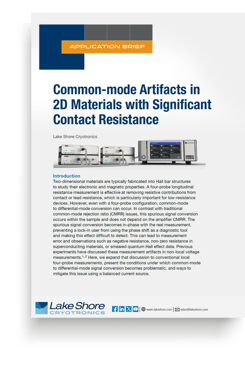
When studying 2D materials, researchers typically fabricate them into Hall bar structures to characterize their electronic and magnetic properties. For such applications, a four-probe longitudinal resistance measurement is effective at removing resistive contributions from contact or lead resistance, which is particularly important for low‑resistance devices. But the situation changes when measuring 2D samples with large contact resistance. Even with a four-probe resistance configuration, common-mode to differential-mode conversion can occur, and this spurious signal conversion can lead to measurement error when performing transport experiments on such materials.
To learn more about how to prevent the spurious signal generation from contact resistances, read our new application brief on “Common-mode Artifacts in 2D Materials with Significant Contact Resistance.” In it, we discuss conditions under which common-mode to differential-mode signal conversion becomes problematic and then show ways to mitigate this issue using a balanced current source.

